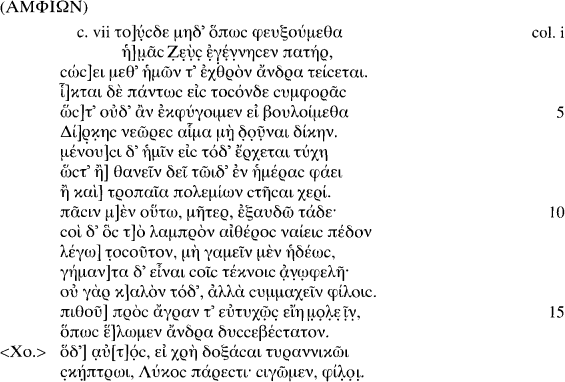No CrossRef data available.
Published online by Cambridge University Press: 28 February 2013
Here is a text which incorporates all the readings and supplements which I explain below and some which I do not.

1. I have printed here what I can read in the papyrus: 12] ![]() (Ṭ hitherto unreported; right tip of horizontal visible); 13 … φ. λη Mahaffy, [ανω]ϕελη Schaal, Page, Kambitsis, αν[ω]ϕελη Blass3, but trace of Ω visible. And I shall do so in what follows, but I shall not always draw attention to newly deciphered letters where the text is not in doubt.
(Ṭ hitherto unreported; right tip of horizontal visible); 13 … φ. λη Mahaffy, [ανω]ϕελη Schaal, Page, Kambitsis, αν[ω]ϕελη Blass3, but trace of Ω visible. And I shall do so in what follows, but I shall not always draw attention to newly deciphered letters where the text is not in doubt.
2. To the instances ![]() cited by the lexica add S. fr. 210.71 Radt.
cited by the lexica add S. fr. 210.71 Radt.
3. And perhaps El. 692/694. See Studies on the Text of Euripides (1981) 39Google Scholar.
4. Cf. Maas, P., ‘De Deorum cum feminis mortalibus concubitu’, Kl. Schr. (1973) 66–7Google Scholar.
5. See KG 2.80, van Otterlo, W. A. A., Med. Ned. Akad. Wet., Letterkunde 7 (1944) 21–31Google Scholar.
6. On this line see CR 40 (1990) 9Google Scholar = Euripidea 358. To counter my argument that ![]() is corrupt, since in this idiom only the finite verb has an object, none being needed by the participle, D. J. Mastronarde (in his commentary, 1994) cites as an example of repeated object S. OC 982–4
is corrupt, since in this idiom only the finite verb has an object, none being needed by the participle, D. J. Mastronarde (in his commentary, 1994) cites as an example of repeated object S. OC 982–4 ![]()
![]() . Here the credit of με is not enhanced by the appearance of u.oi at the end of the sentence. I suggest
. Here the credit of με is not enhanced by the appearance of u.oi at the end of the sentence. I suggest ![]() , like OC 1352
, like OC 1352 ![]() E. Andr. 385
E. Andr. 385 ![]() . Dr R. D. Dawe reminds me of his conjecture at OT 1191–2
. Dr R. D. Dawe reminds me of his conjecture at OT 1191–2 ![]() (δόξαντ’ codd., δόξαν Stob.)
(δόξαντ’ codd., δόξαν Stob.) ![]() .
.
7. See Gnomon 47 (1975) 289–90Google Scholar = Euripidea 145–6.
8. He is addressed by Lycus as ἄνθϱωπε, a vocative attested in tragedy only in addresses to anonymous persons (S. Ai. 791, 1154). The case for Amphion, argued by Webster, T. B. L., The Classical Tradition: Literary and Historical Studies in Honor of Harry Caplan, ed. Wallach, L. (1966) 96Google Scholar, is refuted by Hose, M., Studien zum Chor bei Euripides 1 (1990) 270–1Google Scholar.
9. Here I write ![]() not
not ![]() . See Mastronarde, D. J., ed. Phoen. (Teubner 1988) xxii–iii, and my app. crit. at Ba. 5Google Scholar.
. See Mastronarde, D. J., ed. Phoen. (Teubner 1988) xxii–iii, and my app. crit. at Ba. 5Google Scholar.
10. Seidler, , De versibus dochmiacis (1811–1812) 412Google Scholar, took ![]() as a solitary cretic interposed between dochmiacs. Against such solitary interposed cretics see CQ 40 (1990) 107–9Google ScholarPubMed = Euripidea 373–6.
as a solitary cretic interposed between dochmiacs. Against such solitary interposed cretics see CQ 40 (1990) 107–9Google ScholarPubMed = Euripidea 373–6.
11. In his edition of Stob. (Göttingen 1792). The same conjecture was made by Schmidt, F. W., Kritische Studien zu den griechischen Dramatikern 2 (1886) 453Google Scholar, but he accepted Meineke's ἴδηι.
12. First in a paper published in 1847 (= Études sur le drame antique (1897 [1908 2]) 232 n. 1)Google Scholar, again in REG 2 (1889) 334Google Scholar.
13. SBAM 1878, ii. 181Google Scholar.
14. For the confusion of ἐπι- and ὑπο- see Studies on the Text of Euripides 40. Stob. will be guilty of (virtual) haplography (ἔλαθεν for ![]() ), the papyrus of lipography (ἔπεϲεν for
), the papyrus of lipography (ἔπεϲεν for ![]()
![]() ).
).
15. ![]() fere codd. (
fere codd. (![]() L, ἐνν- Tr), ἐνέπεϲον Mess, ἐπέπεϲον Aldina (cf.
L, ἐνν- Tr), ἐνέπεϲον Mess, ἐπέπεϲον Aldina (cf. ![]() ).
).
16. Fr. 493.1–2 as printed by Kannicht and Snell reads ![]()
![]() . I should expect, rather,
. I should expect, rather, ![]()
![]() (Herwerden), like E. Archel. fr. 255.3 (29.3 Austin)
(Herwerden), like E. Archel. fr. 255.3 (29.3 Austin) ![]() (and for Δίϰη as subject of ὁϱᾶι see the passages cited under (iv) below).
(and for Δίϰη as subject of ὁϱᾶι see the passages cited under (iv) below).
17. Heitsch, E., Die griechischen Dichterfragmente der röm. Kaiserzeit 1 2 (1963) 26Google Scholar.
18. ![]() (Kannicht) not
(Kannicht) not ![]() (edd.). See KB 1.365, Chandler, H. W., A Practical Introduction to Greek Accentuation (1881 2) §670.5Google Scholar.
(edd.). See KB 1.365, Chandler, H. W., A Practical Introduction to Greek Accentuation (1881 2) §670.5Google Scholar.
19. Just as at Hel. 1681 the context demands 2nd-person dual ϲϕῶιν not 3rd-person ϲϕῶν. By contrast, at 106 ![]() . … … (that is all that I can read; εϲϲϕϱ .. […] Mahaffy),
. … … (that is all that I can read; εϲϲϕϱ .. […] Mahaffy), ![]() (2nd-person dual), which features in many conjectures, is impossible. Only ἐϲ ϲϕᾶϲ would be possible, but that was probably not written, and in any case ἐϲ is unlikely, since the papyrus always has εἰϲ.
(2nd-person dual), which features in many conjectures, is impossible. Only ἐϲ ϲϕᾶϲ would be possible, but that was probably not written, and in any case ἐϲ is unlikely, since the papyrus always has εἰϲ.